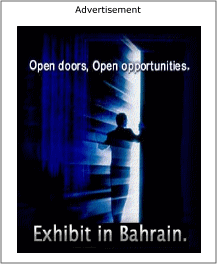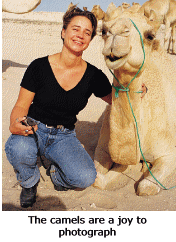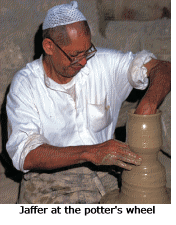|
SUNDAY: Beautiful baskets, historic homes and cute baby camels. For my second day here, breakfast is at the Ramada Hotel's French restaurant Le Jardin. While it's still early morning, a walk around the old district of Manama is very pleasant in the cooler air and we see one of the old houses preserved with a wind tower as I described yesterday whilst another has a lovely old ornate wooden balcony.
 Ali and I then drive out of town to Al Jasra Handicraft Centre, which is well worth visiting even if it's a bit early in the trip to buy souvenirs. It's a good idea to look at what is available especially in regard to locally made items including palm weaving, pottery and woodwork. Ali and I then drive out of town to Al Jasra Handicraft Centre, which is well worth visiting even if it's a bit early in the trip to buy souvenirs. It's a good idea to look at what is available especially in regard to locally made items including palm weaving, pottery and woodwork.
Close by is Beit Al Jasra, another of Bahrain's historic homes which has been restored to its original condition. This was the birthplace of former Amir Shaikh Isa bin Salman Al Khalifa, who was Amir of Bahrain from 1961 to 1999. The house was built in 1907 using coral and gypsum with palm tree trunks used to strengthen the walls. Like other homes from that period, there is a large open courtyard that is accessible from the various small and larger rooms surrounding it. While you cannot actually go inside the rooms, you can see and photograph each room's delicate contents, which are displayed behind protective transparent screens.
Leaving here, we head west to the coast and the 25km King Fahad Causeway, which connects Bahrain and Saudi Arabia across the sea. The causeway makes for a very impressive sight, with wide dual carriageways close to the size of a motorway in the UK.
We drive up to the halfway point where there is a big artificial island that houses customs and immigration. Here there are also two tall towers, one of which we go up to take in the superb view across to Bahrain on one side and Saudi Arabia on the other. We will return here again one evening to take photographs by night. Although it is a good subject by daylight, it is even more so at dusk when the lights in Bahrain are being turned on whilst still just enough daylight remains to see the detail of the causeway. It is the type of night shot that I am very fond of taking. Using a time exposure with the camera on a tripod, you can get the added interest of all the vehicle lights drawing white lines on the film with their headlights, plus red lines drawn by the tail lights! If you wish to do this from the tower, beware of reflections in the windows you view through - put the camera close to the glass and shield it as best as you can from reflections - not easy but quite possible.
We make our way back across the causeway in time to see a couple of archaeological sites before lunch. One of these is the Diraz Temple dating back to the Dilmun era. It's quite small and less is known about it than other Dilmun temples. One thing that is known is that it is very, very old - dating back to the second millennium BC.
Time for lunch, which we take in the pleasantly covered courtyard of Mezzaluna restaurant. Then we head out once again, this time to Jidhafs Village and market on the outskirts of Manama. Having visited here before - it is in fact Ali's home village - I feel at home myself because I have yet to visit a more friendly Arab market! It's always a hive of activity with fruit, vegetables and fish in abundance and all very photogenic. What is more, everyone here loves to be photographed which is a real joy because people at work in markets always provide interesting picture material. Whether it's elderly men carrying huge melons or stocks of the incredible variety of small and large fish, one can hardly go wrong with a camera. However even here it's best to ask before making someone a subject of your photography. This has nothing to do with Arab sensitivity; it's just plain common sense.
 A while later we are on our way to the village of Karbabad, famous for its handicrafts - especially basket weaving. You will find many beautifully made items here. My favourite is the circular woven mats of all sizes made mainly from split palm fronds and coloured with natural dyes. Together with wall hangings and different sized baskets, there are some great gifts here to take back home. A while later we are on our way to the village of Karbabad, famous for its handicrafts - especially basket weaving. You will find many beautifully made items here. My favourite is the circular woven mats of all sizes made mainly from split palm fronds and coloured with natural dyes. Together with wall hangings and different sized baskets, there are some great gifts here to take back home.
Not far away, be sure to visit the camel farm in Janabiya. Here in the late afternoon we witnessed the impressive sight of big groups of camels returning from a day's grazing out on the semi desert scrubland. They made great photos as they lined up to drink at the long water troughs. There is nearly always at least one baby camel to be seen as well which needless to say is a delight for children, besides being irresistible to photograph!
Soon it was feeding time for us humans as well and we chose the Primavera at the Ritz Carlton hotel (formerly Le Royal Meridien). This is an excellent Italian restaurant with great views of Bahrain. Later in the evening, we go visiting the nightclubs at some of the other hotels to catch some live music. Almost every hotel in Bahrain features live bands, so it is good to ask around for recommendations before deciding which club to visit.
After a few hours of music, we call it a night - after all, we need to be fresh for the activities planned for Day 3.
MONDAY: From burial mounds to the Tree of Life, plus a lesson in pottery. Monday starts with breakfast at Coco's, a coffee shop in Adliya, before we drive out to A'ali village, famous for its pottery traditions. Once again I'm delighted to have a very photogenic subject with pots of many different styles and sizes being created on traditional potter's wheels. Again it's a super place for locally made souvenir items to take home, but be careful of the weight mounting up in your suitcase!
 An added bonus during this visit was to meet Jaffer Mohammed Al Shughul, the senior member of the potter's family, whom we posed with at the wheel with his admiring grandchildren looking on. An added bonus during this visit was to meet Jaffer Mohammed Al Shughul, the senior member of the potter's family, whom we posed with at the wheel with his admiring grandchildren looking on.
It's an experience to see and photograph the clay being prepared. This is done by hand, or I should say foot, because the way it is softened is by stamping all over a large wedge of it with bare feet, over and over, until it is pliable. Terrific for close up shots with a difference. The old kilns are still used to fire the pieces and the styles are representative of pottery found at ancient Dilmun sites, so you can be assured that this is a truly traditional place worth visiting.
A'ali village is also where you will find the largest prehistoric cemetery in the world. There are literally thousands of ancient burial mounds here, naturally weathered with time. The mounds date back to between 600 AD and 3000 BC. Few are actually intact, their contents having been looted over the centuries. You can study a close-up of a burial mound at the National Museum, as I mentioned earlier, but to appreciate the sheer scale of it, a visit to A'ali is a must.
« Previous Page | Next Page »
1 | 2 | 3 | 4 | 5
RELATED LINKS:
101 Things to See and Do in Bahrain
In search of the Garden of Eden
Around the Island in 24 Hours
|

